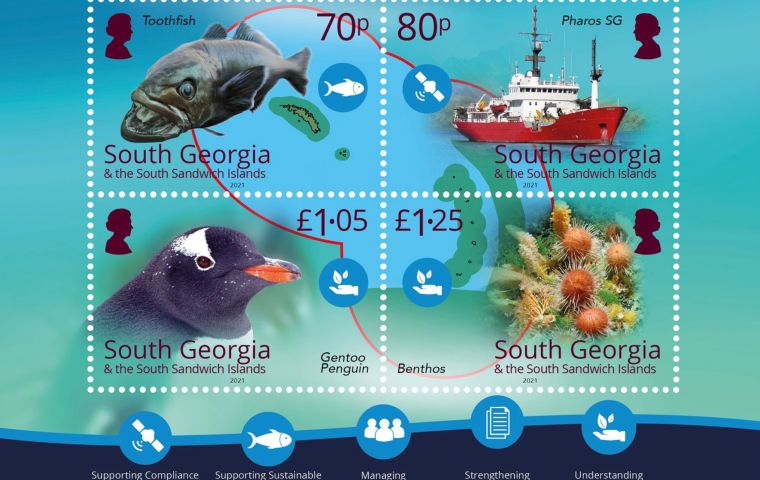MercoPress. South Atlantic News Agency
South Georgia releases Blue Belt Program stamps
 The SGSSI toothfish fishery is recognized by the Marine Stewardship Council as being one of the most sustainably managed in the world.
The SGSSI toothfish fishery is recognized by the Marine Stewardship Council as being one of the most sustainably managed in the world. The Government of South Georgia & the South Sandwich Islands is releasing a stamp set to celebrate its involvement in the UK Blue Belt Program.
The UK Blue Belt Program recognizes that UK Overseas Territories are home to a globally significant biodiversity and since 2016 has worked with the Governments of these Territories to enhance the protection and management of these precious marine environments.
The Blue Belt enhances marine protection by supporting work in five key areas:
• understanding and protecting biodiversity
• strengthening governance
• managing human impacts
• supporting sustainable fisheries management
• supporting compliance and enforcement
The Blue Belt Program helps UK OTs and the UK work together to improve understanding of the effectiveness of Marine Protected Areas (MPAs) and how to improve them. This work is supported by two world leading organizations, the Centre for Environment Fisheries and Aquaculture Science, (Cefas), ans the Marine Management Organization (MMO).
The South Georgia and South Sandwich Islands Marine Protected Area (SGSSI-MPA) is one of the world’s largest MPAs, covering an area of 1.24 million km2. The MPA aims to conserve the rich marine biodiversity within the Territory’s maritime zone and provides a framework for our marine environmental management and research needs.
To help protect the marine environment all trawl fishing on the seafloor is prohibited throughout the MPA. Longline fishing for toothfish is limited to depths between 700 – 2250 m covering less than 6% of the MPA area to conserve bio-diverse seafloor habitats. The longline fishery is also restricted to just 137 days a year in winter at South Georgia, which has helped to eliminate albatross by-catch.
The South Georgia krill fishery is also confined to winter months when most species of krill feeding predators including penguins, seals and whales are absent or at much lower densities. No commercial krill fishing has taken place at the South Sandwich Islands for over 30 years when very small research catches were taken.
These stamps highlight and celebrate some of the key elements of the SGSSI MPA.
70p – Toothfish
Patagonian toothfish are large, long-lived, deep-water species, belonging to the Nototheniidae family. Today the SGSSI toothfish fishery is recognized by the Marine Stewardship Council as being one of the most sustainably managed in the world. The fishery has strict protocols in place to ensure that the environment is not harmed due to fishing activities. The fishery also generates revenue that is used to fund research into marine management including albatross conservation and efforts to further protect them.
80p – Pharos SG
Pharos SG is the dedicated SGSSI fisheries patrol vessel and helps ensure licensed vessels are compliant with fishery regulations and is instrumental in the fight against illegal, unregulated and unreported (IUU) fishing activity, which could seriously damage fish populations and the marine environment.
£1.05 – Gentoo Penguin
Krill is an important food source for gentoo penguins and so as part of the management of the MPA, their population status and foraging habits are continually monitored and management steps taken to reduce overlap with the fishery. As part of their higher predator monitoring program, the British Antarctic Survey (BAS) monitor breeding success of gentoo penguins at Bird Island and Maiviken and have recently undertaken work to equip birds with satellite transmitters so as to better understand overlap between where the birds feed and licensed fishing activities.
£1.25 – Benthos
Although the biodiversity of the seabed is generally poorly understood, sampling around SGSSI indicates that there is a huge diversity and many species that are not found anywhere else. To protect this precious resource a number of special protection measures are in place within the MPA including no-take zones close to the coastline and specific benthic closed areas in regions where research has shown there is particularly high biodiversity. Cameras have been deployed across the MPA to assess the distribution and abundance of seafloor organisms.
The stamps are available to purchase through https://www.falklandstamps.com




Top Comments
Disclaimer & comment rulesCommenting for this story is now closed.
If you have a Facebook account, become a fan and comment on our Facebook Page!